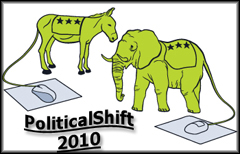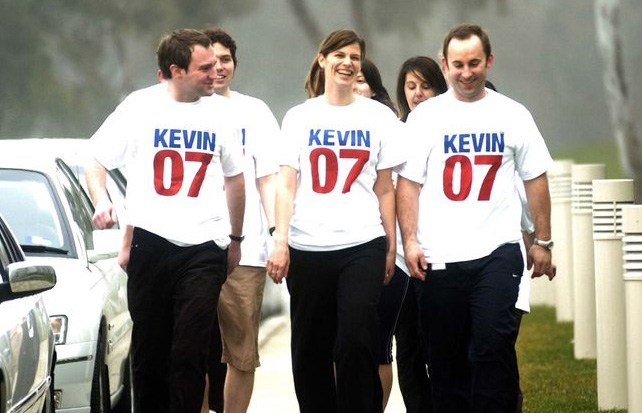
The Digital Age has seen significant change in the way Australian politicians, political journalists and the public interact and communicate with each other. As a result, MediaShift asked me to identify the top five events in Australia’s recent history where politics and new media intersected.
My shortlist, compiled with crowdsourcing assistance from my politically engaged Twitter and Facebook communities, includes a quintessentially Australian slogan that went viral; the demise of an opposition leader that played out via Twitter and demonstrated the transformative effect of the medium on political reporting; the Twitter-cast of the extraordinary political coup that ousted a Labor Prime Minister in his first term; a bold High Court challenge to the curtailment of voter registration by an activist online media outfit; and the unmasking of a popular blogger and media critic by a political journalist in the aftermath of the 2010 federal election.
Here’s a list that describes each event, and the impact of new media on Australian politics.
1. Kevin07
The 2007 campaign to elect Kevin Rudd Prime Minister of Australia was the country’s first social media election. After 12 years of conservative government led by John Howard, a man who epitomized 1950s values, Rudd’s campaign appeared positively contemporary and technologically cutting edge.

The campaign incorporated a moderately interactive website, blogs, email, YouTube, MySpace (back when it was hip) and Facebook to generate political interest among young voters who slapped Kevin07 t-shirts on their backs and added slogan bumper stickers to their cars, while also posting badges on their Facebook walls.
The Kevin07 campaign couldn’t hold a candle to Obama’s groundbreaking social media strategy in the year that followed, but it highlighted the stark contrast between the tech-savvy Rudd and yesterday’s leader. And it visibly contributed to the activation of the voters who ultimately delivered Rudd a landslide victory that even cost Howard his seat in parliament.
Ironically, though, it was Rudd’s perceived disconnectedness from the electorate, perhaps fueled by his failure to live up to expectations of engagement generated by social media accessibility during the campaign, that cost him the prime ministership in a bloodless coup, less than three years later (see #Spill2 below).
2. #Spill
The dramatic unseating of Australia’s Opposition Leader, the Liberal Party’s Malcolm Turnbull, in December 2009 was extraordinary for many reasons. One of them was the role of Twitter in the drama. (I reported in detail on this for MediaShift earlier this year)
The hashtag #Spill was used to aggregate Twitter commentary on the Liberal leadership crisis by Australian Twitter users. At one point, it became the fifth most popular trending topic worldwide.
The message was clear: There was a new electorate in Australia and it was on Twitter. It wasn’t an actual electorate, of course, but it was an emerging homeland for politically engaged citizens and new territory to be invaded by political journalists. As members of Canberra’s Press Gallery poured onto Twitter, the transformative impact of Twitter on journalism was demonstrated. It broke down the barriers that traditionally separated journalists from audiences, segregated competing reporters and filtered communications between politicians and their constituents. The potential for a new form of participatory democracy, one which provided opportunity for unmediated interaction between audiences, the Fourth Estate and politicians was on display — in real time.
3. #Spill2
One Twitter-exposed leadership spill wasn’t enough for Australia. When Julia Gillard usurped her leader, Kevin Rudd, as Prime Minister in June this year in a bloodless coup that unfolded at lightning speed, the story was broken on Twitter.
It was one of the most dramatic political stories in Australian history — the first time a sitting prime minister had been ousted by his own party during his first term in office.
Here’s how Chris Uhlmann, political editor of ABC’s 24 hour TV news channel, alerted his followers on June 23 that a leadership spill was likely:
Kevin Rudd’s leadership is under siege tonight from some of the Labor Party’s most influential factional warlords. Watch ABC News. NOW!
Chief political correspondent for multicultural and multilingual broadcaster SBS, Karen Middleton tweeted that Labor powerbrokers had entered Rudd’s office, highlighting the stunning speed with which events were unfolding: “NO confirmation that Gillard is willing to move against Rudd. Some frontbenchers oblivious.”
By the end of the night, prolific Canberra Press Gallery Twitter user Latika Bourke tweeted: “Text from Labor MP: ‘it’s done. There will be a new PM tomorrow.”
Less than 12 hours later, behind closed doors in Canberra’s Parliament House, Rudd’s fate was sealed. And the news broke first on Twitter via News Limited journalist Samantha Maiden who tweeted this:
Labor Mp text: it’s Julia no ballot #spill
That tweet was re-tweeted over 90 times and featured in her competitor’s news copy as the real-time medium trumped the immediacy of traditional media outlets – even the original real-time medium, radio.
As Sky News Digital News Director John Bergin wrote in the Walkley Magazine in the aftermath of the coup, “The breakneck pace of the strike on Rudd’s Prime Ministership was only intensified by the immediacy of the real-time web.”
The second #Spill, which was variously tagged #Spill2 and #Spillard (a reference to incoming Prime Minister Gillard, cemented the role of Twitter in political reporting and further demonstrated its impact on journalism. It also highlighted the potential power of the platform as a facilitator of participatory democracy.
4. GetUp! Wins in High Court
The online activist media group GetUp! achieved a significant legal victory in the interests of Australian democracy in the midst of the August 2010 federal election, which was so tightly contested that it resulted in an historic hung parliament.
With a suite of pro-bono lawyers, GetUp! joined forces with the Human Rights Law Centre in a public democracy campaign that ended in a High Court (Australia’s highest court of appeal) challenge to restrictive voter registration laws introduced by the long-lived conservative Howard government.
GetUp! successfully argued that the changes, which resulted in the early closure of voter enrollment on the day a poll was declared, effectively disenfranchised young people, the homeless and Indigenous Australians.
The win legitimized the enrollment of over 100,000 Australians who registered to vote within seven days of the August election being called, meaning their votes counted on polling day and ultimately helped deliver a minority government to the Labor Party, which had welcomed the High Court ruling.
5. Groggate
There’s now a fork in the Twitter road to journalistic transformation in Australia, and it was signposted by what Rupert Murdoch’s newspaper The Australian described as “the great blog war of 2011” — a war that the newspaper started.
Eighteen months ago, I wrote [PDF] that journalists needed to be space invaders in the Twittersphere. What I meant by that was that they needed to be present and engaged. But some have seen the platform’s rise, and the leveling effect it brings to information distribution, as a call to combat. They’ve adopted principles of trench-warfare, lobbing tweet-length ‘grenades’ at citizens who are encroaching into their territory.
This collision of a select group of tweeting professional journalists and their online critics came to a head in midst of the 2010 election campaign thanks to a seminal post by the popular blogger Grog’s Gamut. The pseudonymous writer stridently criticized what he described as the shallow, trivial campaign trail coverage by Canberra Press Gallery journalists and he called for a greater focus on policy analysis in the coverage.
Some defensive journalists, apparently threatened by the disruption of control represented by the traction of the Grog’s Gamut critique, denied there was a problem with their coverage, while others reflected thoughtfully on the issues raised by the blogger.
Remarkably, the Australian Broadcasting Corporation’s managing director, Mark Scott, ultimately re-directed election news coverage to emphasize policy in response to the public debate triggered by the Grog’s Gamut blog.
The defensive members within the political reporting pack started a flame war with critics that continued on Twitter throughout the campaign and exploded with the retaliatory unmasking of Grog’s Gamut as Dr. Greg Jericho, a federal public servant, by The Australian’s James Massola. The newspaper claimed the unmasking was a matter of public interest. I argued at the time that it was not. The Twitterstorm that erupted in response to the unmasking was volatile.
The #Groggate saga, as I facetiously labeled it on Twitter, demonstrated both one of the causes of public distrust in journalism and the potential cost of eroding trust built on audience engagement. These costs were evident in the angry public backlash against journalists at The Australian, Massola’s loss of Twitter followers in the immediate aftermath, and a further erosion of The Australian’s editorial credibility.
It also highlighted the risks of disrespecting online community values, mores and ethics… along with some spectacular examples of professional arrogance by journalists at the center of the storm.
#Groggate was a case study in how to alienate online audiences and lose influence in the emerging new media spaces that are playing host to a vibrant Australian public political debate.
Disclosures: I am the Australian editorial director of Media140 and I invited James Massola to speak at the Canberra conference, themed on the politics of social media, on September 23. I also invited Grog’s Gamut to blog the event for Media140 with the promise that I would do my utmost to help preserve his pseudonymity during the conference. And I began the Twitter hashtag #Groggate as a facetious reference to the prominence The Australian gave the original story.
Julie Posetti is an award winning journalist and journalism academic who lectures in radio and television reporting at the University of Canberra, Australia. She’s been a national political correspondent, a regional news editor, a TV documentary reporter and presenter on radio and television with the Australian national broadcaster, the ABC. Her academic research centers journalism and social media, on talk radio, public broadcasting, political reporting and broadcast coverage of Muslims post-9/11. She blogs at J-Scribe and you can follow her on Twitter.



